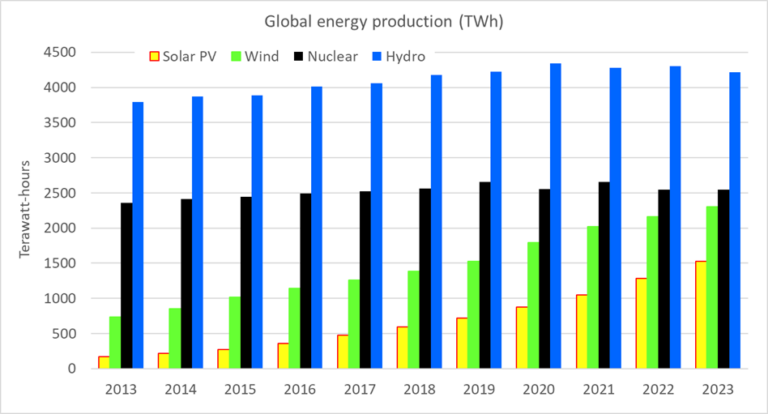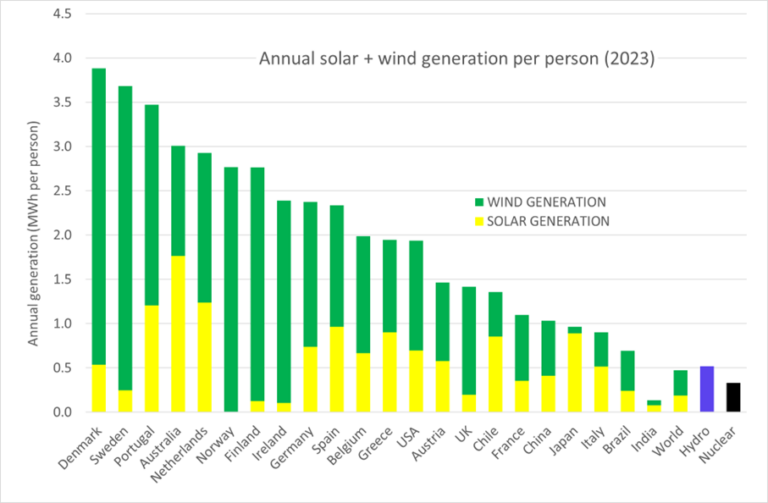The International Solar Energy Society (ISES) explains how solar and wind energy dominate power plant construction.
In 2023, solar PV and wind together constituted 80% of global net energy capacity additions. The growth in energy capacity is followed by the growth in annual energy generation.
Over the last decade, global PV generation has increased nine-fold to 1,500 TWh per year, while wind generation has tripled to 2,300 TWh per year (Figure 1). This corresponds to compound growth rates of 22% and 11% annually respectively. On the other hand, hydroelectric, nuclear and coal generation had growth rates of around 1% annually, and natural gas, 3%.

Figure 1: Global low-emissions annual electricity generation (Ember, WNA)
Image: Ember, WNA
The photovoltaic growth rate of 22% per year is equivalent to doubling every 3 years. At this growth rate, PV generation will reach 100,000 TWh per year in 2042, which is enough to completely decarbonize the global economy.
Nuclear power has a global average capacity factor of 74%, followed by coal (50% to 70%), combined cycle gas (40% to 60%), wind (30% to 60%), large hydroelectric plants (30% to 50%). ), and solar photovoltaic energy (from 12% to 25%).
Despite its relatively low capacity factor, photovoltaic generation is on track to surpass nuclear generation in 2026, wind in 2027, hydro in 2028, gas in 2030 and coal in 2032.
Photovoltaics and wind strongly dominate power plant construction, while construction of all other generation technologies is small and stagnant. Coal, gas and nuclear could largely disappear by mid-century, once retirements outpace new construction.
The leading countries in PV and wind generation per capita are all in Europe, except Australia (Figure 2). Also shown in Figure 2 is the global generation per capita from hydroelectric and nuclear power. Combined photovoltaic and wind power generation in leading countries is now four times greater than the global average hydropower and nuclear power generation combined.

Figure 2: Solar and wind electricity generation per person (Ember, WNA)
Image: Ember, WNA
Australia is a global pioneer because, unlike Europe, it cannot share electricity across national borders to reduce the effects of variable weather and demand. Australia must do it alone. Australia is convincingly demonstrating that change can happen quickly with good policies. Over the period 2020 to 2030, fossil generation is falling from 75% to 18%, while photovoltaic and wind generation is increasing from 19% to 75%.
Brazil and Chile are pioneering middle-income countries, with approximately 81% and 60%, respectively, of electricity generation coming from hydro, wind and photovoltaic energy. Pioneering countries are driven by the desire to reduce both electricity prices and emissions. There are few serious concerns about future grid stability because there will be sufficient investment in storage, transmission and demand management.
Authors: Prof. Ricardo Rüther (UFSC), Prof. Andrew Blakers /ANU
ISES, the International Solar Energy Society is a UN-accredited membership NGO founded in 1954 working towards a world with 100% renewable energy for all, used efficiently and wisely.
ISES, the International Solar Energy Society is a UN-accredited membership NGO founded in 1954 working towards a world with 100% renewable energy for all, used efficiently and wisely.

